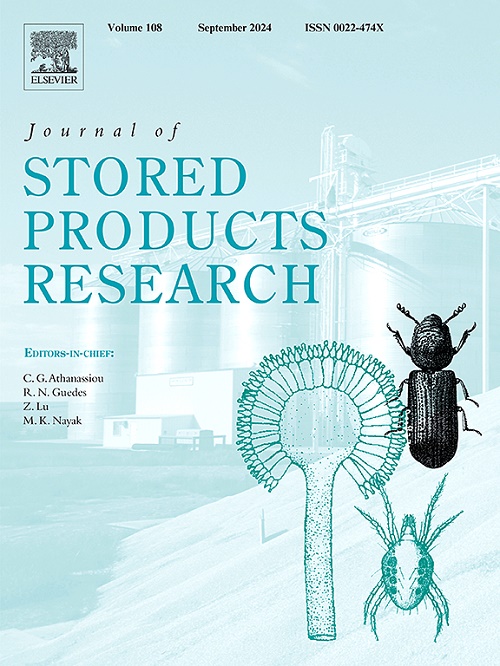Effect of ozone gas on Attagenus fasciatus (Thunberg) (Coleoptera: Dermestidae) and Gibbium psylloides (Czempinski) (Coleoptera: Ptinidae) as stored silkworm product pests
IF 2.7
2区 农林科学
Q1 ENTOMOLOGY
引用次数: 0
Abstract
The insecticidal potential of ozone gas was tested against two insect pests of stored silkworm products, Attagenus fasciatus (Thunberg) (Coleoptera: Dermestidae) and Gibbium psylloides (Czempinski) (Coleoptera: Ptinidae). Ozone was tested at three concentrations, 500, 1000 and 1500 ppmv for three exposure times, 1, 2 and 3 h. The adult mortality of two insects was counted during 7 days of treatment. Changes in the morphological features of two insect's adults were examined under scanning electron microscope (SEM) and the chemical composition of treated silkworm cocoons with ozone was determined. Adult mortality of A. fasciatus and G. psylloides was improved with the increase in ozone concentration and exposure time. Thus, all tested concentrations caused complete adult mortality of A. fasciatus after 3 and 5 days of treatment at two exposure times (2 and 3 h), respectively. While the two concentrations of ozone (1000 and 1500 ppmv) caused full mortality of G. psylloides adults after 5 days of treatments at exposure time 3 h. Examination with SEM of treated adults showed induction malformations on the dorsal surface as split between elytra and between the thorax and elytra as well as a split the head capsule from the thorax. Additionally, there was a decrease in the density of some microtrichiae of A. fasciatus. While in case of G. psylloides, observed induction shrinking and deformities occurred in the abdominal cuticles and the abdomen was exploded as results treating of ozone gas. Furthermore, the chemical composition analysis of treated silkworm cocoons showed a slight decrease in protein and carbohydrate contents and increasing at the fat, moisture, fiber and ash contents. Our results indicated that the ozone gas seems to be a promising fumigant for the control of A. fasciatus and G. psylloides.
臭氧气体对储藏蚕产品害虫 Attagenus fasciatus (Thunberg) (Coleoptera: Dermestidae) 和 Gibbium psylloides (Czempinski) (Coleoptera: Ptinidae) 的影响
测试了臭氧气体对两种贮藏蚕产品害虫的杀虫潜力:Attagenus fasciatus (Thunberg) (Coleoptera: Dermestidae) 和 Gibbium psylloides (Czempinski) (Coleoptera: Ptinidae)。测试的臭氧浓度分别为 500、1000 和 1500 ppmv,暴露时间分别为 1、2 和 3 小时。在扫描电子显微镜(SEM)下观察了两种昆虫成虫形态特征的变化,并测定了经臭氧处理的蚕茧的化学成分。随着臭氧浓度和暴露时间的增加,A. fasciatus 和 G. psylloides 的成虫死亡率有所提高。因此,在两种暴露时间(2 小时和 3 小时)下,所有测试浓度的臭氧在处理 3 天和 5 天后都会导致 A. fasciatus 成虫完全死亡。用扫描电子显微镜检查处理过的成虫,发现其背部出现畸形,即背甲之间、胸部与背甲之间出现裂缝,头囊与胸部之间也出现裂缝。此外,A. fasciatus 的一些微三叶虫密度也有所下降。至于 G. psylloides,臭氧气体处理的结果是腹部角质层出现诱导收缩和畸形,腹部爆炸。此外,对处理过的蚕茧进行的化学成分分析表明,蛋白质和碳水化合物含量略有下降,而脂肪、水分、纤维和灰分含量有所增加。我们的研究结果表明,臭氧气体似乎是一种很有前景的熏蒸剂,可用于控制 A. fasciatus 和 G. psylloides。
本文章由计算机程序翻译,如有差异,请以英文原文为准。
求助全文
约1分钟内获得全文
求助全文
来源期刊
CiteScore
5.70
自引率
18.50%
发文量
112
审稿时长
45 days
期刊介绍:
The Journal of Stored Products Research provides an international medium for the publication of both reviews and original results from laboratory and field studies on the preservation and safety of stored products, notably food stocks, covering storage-related problems from the producer through the supply chain to the consumer. Stored products are characterised by having relatively low moisture content and include raw and semi-processed foods, animal feedstuffs, and a range of other durable items, including materials such as clothing or museum artefacts.

 求助内容:
求助内容: 应助结果提醒方式:
应助结果提醒方式:


